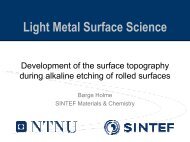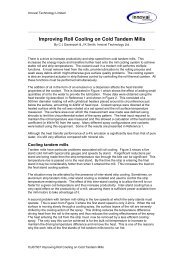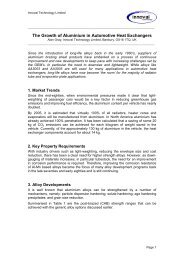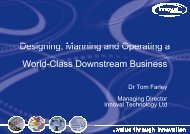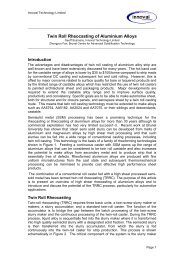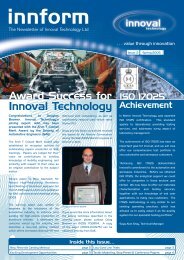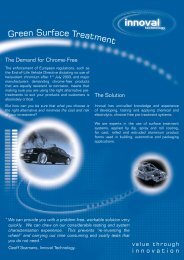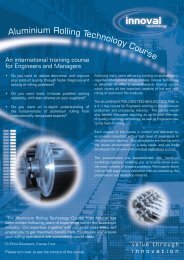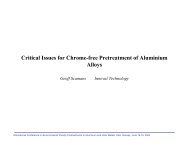Pretreatment of Aluminium â An Overview - Innoval Technology Ltd
Pretreatment of Aluminium â An Overview - Innoval Technology Ltd
Pretreatment of Aluminium â An Overview - Innoval Technology Ltd
Create successful ePaper yourself
Turn your PDF publications into a flip-book with our unique Google optimized e-Paper software.
<strong>Innoval</strong> <strong>Technology</strong> Limited<br />
___________________________________________________________________<br />
<strong>Pretreatment</strong> <strong>of</strong> <strong>Aluminium</strong> – <strong>An</strong> <strong>Overview</strong><br />
By Colin Butler and Mark Foster, <strong>Innoval</strong> <strong>Technology</strong> Limited<br />
___________________________________________________________________<br />
Approximately 40% or 17 million tonnes <strong>of</strong> the total world aluminium shipment is in<br />
the form <strong>of</strong> rolled products and used in major markets including packaging (cans,<br />
foil), building/engineering (panels, ro<strong>of</strong>ing, appliances) and transportation<br />
(automotive, aerospace, trains). To ensure satisfactory performance all these<br />
products require modification <strong>of</strong> the surface which can be carried out after the<br />
material has been formed to final shape or more easily by coil surface processing<br />
which usually takes place on dedicated lines.<br />
<strong>Aluminium</strong> strip in either sheet or coil form can be surface treated and coated to<br />
provide a wide variety <strong>of</strong> protective, decorative, or special-property finishes making it<br />
an ideal material for a wide range <strong>of</strong> applications.<br />
The different surface treatments and coatings can be applied on individual sheets or<br />
formed components where process stage times can be relatively long, i.e. measured<br />
in minutes. Since many <strong>of</strong> the applications have now developed into high-volume<br />
markets, the modern tendency is to produce material, wherever feasible, on<br />
continuous strip process lines and so achieve the level <strong>of</strong> productivity required while<br />
minimising costs.<br />
The process stages for paint and lacquer coating have been developed to be<br />
effective in a matter <strong>of</strong> seconds enabling speeds <strong>of</strong> 200 m/min. to be achieved and<br />
even 300m/min. for pretreatment-only lines.<br />
In addition to high productivity, the continuous strip treatment enables strict process<br />
control, can be modified to specific customer product properties and provides a<br />
consistently high standard <strong>of</strong> quality across the strip width, throughout the coil length<br />
and on both top and bottom surfaces.<br />
The surface finishing <strong>of</strong> aluminium involves the following stages:<br />
Cleaning to remove residual oil, oxide films and mechanically disturbed layers<br />
<strong>Pretreatment</strong> to provide corrosion protection and modify the surface for<br />
enhanced adhesion <strong>of</strong> organic coatings<br />
Coating <strong>of</strong> a protective, decorative or special function finish<br />
Cleaning<br />
<strong>Aluminium</strong> may be cleaned to<br />
Remove surface contaminants: residual mill oil and smut<br />
Diminish, in a controlled fashion, or remove surface oxide<br />
Etch the metal to remove near surface active layers<br />
Provide a uniform surface to receive pretreatment
<strong>Innoval</strong> <strong>Technology</strong> Limited<br />
There are three general approaches to cleaning<br />
Alkaline spray or immersion<br />
Acid spray or immersion<br />
Acid electrolytic cleaning<br />
<strong>Pretreatment</strong><br />
The pretreatment process is <strong>of</strong>ten integrated with a preceding strip cleaning process,<br />
and usually a subsequent coating process.<br />
<strong>An</strong> exception is the provision <strong>of</strong> pretreated-only coil which is cut into sheets for the<br />
packaging industry (e.g. food cans, metal closures) where the individual sheets are<br />
lacquered and printed on sheet coating lines. This is because it is not practical to<br />
print or decorate coils due to the wide range <strong>of</strong> designs required, and the relatively<br />
small runs per design.<br />
Pretreated-only strip is coated with 5 to 10 mg/m2 dioctyl sebacate (DOS) to ensure<br />
the cut sheets destack and feed smoothly into the sheet coater/decorators.<br />
The pretreatment can be either a chemical or an electrolytic process, to replace the<br />
natural oxide film. The chemical process is more usual, with different versions for<br />
food packaging applications (to satisfy regulations) and for architectural or transport<br />
applications.<br />
Historically pretreatments for coil coated aluminium were chromium VI based<br />
formulations which provided excellent performance.<br />
Theses chromate conversion coatings relied on a film forming mechanism based on<br />
acidified chromate with fluoride providing a source <strong>of</strong> CrVI ions which were released<br />
in service giving a “self-healing” mechanism in defect/damaged areas.<br />
Formulations based on CrVI are still used for architectural applications while CrIII<br />
systems have been developed for food contact products.<br />
The most commonly used pre-treatment for coil coating is a thin chromate film (~ 200<br />
nm) which provides both good adhesion and corrosion protection.<br />
Solutions can be chromate (yellow chromating) or chromate-phosphate (green<br />
chromating) and can be applied by immersion, spray or chemcoater (no-rinse).<br />
However, as chromium(VI) is toxic, there has been a considerable amount <strong>of</strong> effort to<br />
develop more environmentally friendly alternative pre-treatment systems.<br />
Current alternatives include:<br />
Metal ion analogues to Cr(VI) (Mn, Co) and inorganic molecules reacting with<br />
oxidised Al to form mixed oxides (Ti, Zr)<br />
Inorganic film-forming oxides which cover the surface and promote adhesion<br />
(silicates, molybdates, vanadates)<br />
Organic polymers with high complexing capacity.<br />
In excess <strong>of</strong> 50% <strong>of</strong> global packaging products and 25% <strong>of</strong> European architectural<br />
products use Cr-free pretreatment systems.
<strong>Innoval</strong> <strong>Technology</strong> Limited<br />
Earlier conversion coatings required excess solution to be washed <strong>of</strong>f the metal<br />
surface giving rise to considerable volumes <strong>of</strong> contaminated rinse water requiring<br />
treatment before disposal. However in the case <strong>of</strong> no-rinse application a precise<br />
amount <strong>of</strong> pretreatment solution is applied uniformly across the strip and then dried in<br />
place. These ‘no-rinse’ aqueous chemicals have been formulated to remain on the<br />
aluminium surface. Their reaction with the aluminium means that no products are<br />
formed which will subsequently require removal, so avoiding most <strong>of</strong> the potential<br />
environmental problems.<br />
The pretreatment, typically a no-rinse chrome chemical type, is applied to each side<br />
<strong>of</strong> the strip by roller coating. A typical pretreatment is 120 mg/m2 dry coating weight.<br />
No-rinse chemcoater application<br />
The pretreatment is dried, typically by passing the strip through a hot air oven to<br />
achieve a metal temperature <strong>of</strong> approximately 40 to 60°C. The strip is then air and<br />
water cooled to around ambient temperature and squeegee rolls and an air knife dry<br />
the strip before it passes to the next paint coating stage.<br />
<strong>An</strong> alternative electrolytic pretreatment process is effectively anodizing in a hot<br />
electrolyte using liquid contacts. The power supply can be either d.c (direct current)<br />
or a.c. (alternating current) with the latter either single or 3-phase.<br />
A cell containing an electrolyte (e.g. 20% sulphuric acid) is divided into 2 or more<br />
compartments, with electrodes in each compartment. Current passes between the<br />
electrodes and the strip via the electrolyte - there is no mechanical contact with the<br />
strip.
<strong>Innoval</strong> <strong>Technology</strong> Limited<br />
Electrolytic Cell<br />
By using a.c., graphite electrodes, with slots through which the strip passes, can be<br />
used, pretreating each side <strong>of</strong> the strip simultaneously. The pretreatment film is<br />
produced whilst the strip is subjected to the anodic half-cycle, and the film is modified<br />
by chemical attack during the cathodic half-cycle. Full pretreatment can be effected in<br />
aproximately 3 seconds. When using d.c., either lead, or lead covered, electrodes<br />
must be used in the cathodic section.<br />
If a preceding acid degrease/clean is used, it can employ the same chemical<br />
composition as that in the pretreatment cell (e.g. 20% sulphuric acid) thus avoiding<br />
the necessity <strong>of</strong> rinsing the cleaned strip prior to entering the pretreatment cell.<br />
After the pretreatment and drying stages the strip is coated with a lacquer or paint<br />
depending on the final product application.<br />
Mechanisms<br />
<strong>Pretreatment</strong> functionality is a combination <strong>of</strong> one or more attributes. These attributes<br />
are a result <strong>of</strong> the reactivity <strong>of</strong> the applied chemistry and the structure <strong>of</strong> the resulting<br />
film:<br />
• Formation <strong>of</strong> a barrier layer restricting the flow <strong>of</strong> ions, water and oxygen to<br />
the substrate<br />
• Chemical and mechanical stabilisation <strong>of</strong> the native oxide film<br />
• Production <strong>of</strong> a surface with chemical bonding potential to subsequently<br />
applied organic materials<br />
• Increase <strong>of</strong> surface area available for coating<br />
• To give a mechanically rough surface to enhance interlocking<br />
• Provision <strong>of</strong> electrochemically derived corrosion resistance<br />
Each pretreatment system has at least two <strong>of</strong> these factors at the heart <strong>of</strong> its<br />
performance. The list above can be subdivided into those factors that act on or in<br />
conjunction with the substrate and those that improve interactions with coatings or<br />
adhesives. This subdivision is perhaps obvious however it demonstrates the<br />
importance <strong>of</strong> the pretreatment at the interface between metallic and organic<br />
materials. Furthermore it indicates the critical nature <strong>of</strong> this sub 100µm layer to the<br />
performance <strong>of</strong> a large percentage <strong>of</strong> aluminium used in a coated or bonded form.<br />
What is not obvious but is implied by the various factors is that the structure <strong>of</strong> the<br />
pretreatment layer plays a part in determining performance.
<strong>Innoval</strong> <strong>Technology</strong> Limited<br />
Structure <strong>of</strong> zirconium based pretreatment<br />
TEM cross section through a pretreatment layer<br />
Many pretreatment layers have a structure that varies from the substrate to the outer<br />
surface. This structure occurs as a direct result <strong>of</strong> the applied wet chemistry and the<br />
processing it undergoes. The reaction times, albeit short, are long enough to allow<br />
segregation <strong>of</strong> the film into layers. When the process is optimised, chemical<br />
groupings are found in the correct location to allow desirable interactions with<br />
substrate or coating. Of course the possibility exists for non optimised structure<br />
formation due to process or formulation variation. In these situations the structure
<strong>Innoval</strong> <strong>Technology</strong> Limited<br />
may be mechanically weakened, compromised with regards to hydrolysis or lack the<br />
ability to maintain adhesion to either substrate or coating. Failure <strong>of</strong> the product<br />
during service will <strong>of</strong>ten result.<br />
CONCLUSION<br />
<strong>Pretreatment</strong> represents a small but important cog in a multibillion dollar industry.<br />
However, in the twenty-first century, industry requirements for control and<br />
minimisation <strong>of</strong> failure coupled with increased competition and higher production<br />
speeds place ever increasing demands on pretreated surfaces.




